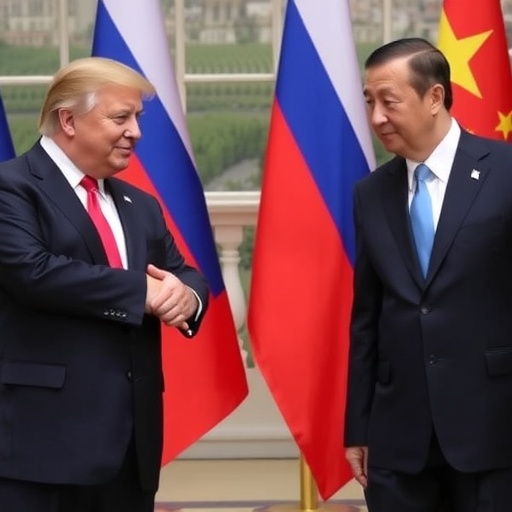Trump Seeks China’s Crucial Assistance in Forging Russia-Ukraine Peace Deal During Asia Tour
In a bold diplomatic pivot, US President Donald Trump has publicly called on China to play a pivotal role in negotiating a peace deal with Russia over the ongoing Ukraine conflict, a move that could reshape global alliances and ease tensions in Eastern Europe. Speaking from the tarmac upon arriving in Asia for a high-profile tour, Trump emphasized the need for Beijing’s influence to pressure Moscow into concessions, marking a surprising outreach amid strained US-China relations.
- Trump’s Urgent Appeal to Xi Jinping Amid Escalating Ukraine Crisis
- China’s Strategic Leverage Over Russia in the Geopolitical Chessboard
- Navigating Fractured US-China-Russia Relations Under Trump’s Leadership
- Potential Ripple Effects on Global Security and Trade Dynamics
- Charting the Path Forward: Trilateral Summits and Beyond
Trump’s Urgent Appeal to Xi Jinping Amid Escalating Ukraine Crisis
President Trump’s Asia itinerary, which kicked off this week, is centered on a landmark summit with Chinese President Xi Jinping in Beijing, where the US leader plans to directly solicit China’s help in mediating the Russia-Ukraine war. “China has the leverage with Russia that we need to bring this senseless conflict to an end,” Trump stated in a press briefing aboard Air Force One, underscoring his administration’s strategy to leverage Beijing’s economic ties with Moscow. The Ukraine invasion, now in its third year, has resulted in over 500,000 casualties and displaced millions, according to United Nations estimates, making any prospect of peace a global imperative.
Trump’s overture comes at a critical juncture. Russia’s military advances in eastern Ukraine have intensified, with recent reports from the Institute for the Study of War indicating that Kremlin forces control nearly 20% of Ukrainian territory. By involving China, Trump aims to exploit Beijing’s position as Russia’s largest trading partner—bilateral trade reached $240 billion in 2023, per Chinese customs data— to encourage de-escalation. This approach contrasts with the Biden-era focus on isolating Russia through Western sanctions, which Trump has criticized as ineffective.
During the flight to Asia, Trump aides revealed that preliminary talks with Chinese diplomats have already outlined potential incentives, including eased US restrictions on technology exports to China in exchange for Beijing’s diplomatic pressure on Vladimir Putin. “We’re not asking for charity; we’re offering a path to mutual benefit,” a senior White House official told reporters, speaking on condition of anonymity. This quid pro quo highlights the intricate balance Trump is navigating, where enlisting China could accelerate peace but risks alienating European allies wary of empowering Beijing.
China’s Strategic Leverage Over Russia in the Geopolitical Chessboard
China’s unique position in the Russia-Ukraine equation stems from its deepening partnership with Moscow, forged in response to Western isolation. Since the 2022 invasion, China has maintained a policy of “strategic neutrality,” abstaining from UN votes condemning Russia while providing indirect support through dual-use exports. Satellite imagery analyzed by the Center for Strategic and International Studies shows increased Chinese shipments of machinery and electronics to Russian ports, fueling speculation about covert aid.
Yet, President Xi Jinping has repeatedly voiced support for a negotiated settlement. In a September 2023 speech at the UN General Assembly, Xi called for an “inclusive peace process” that respects all parties’ sovereignty, a stance that aligns with Trump’s vision. Analysts believe China’s economic clout—Russia relies on Chinese markets for 30% of its oil exports, according to the International Energy Agency—gives Beijing the tools to influence Putin’s calculus. If Xi agrees to Trump’s request, it could involve hosting trilateral talks or using backchannel diplomacy to broker ceasefires in key battlegrounds like Donetsk and Kharkiv.
Historical precedents bolster this strategy. During Trump’s first term, China mediated in the 2018 US-North Korea summits, demonstrating its diplomatic prowess. A former US ambassador to China noted, “Beijing thrives on being seen as a global peacemaker; this could elevate Xi’s stature on the world stage.” However, challenges abound: China’s own territorial disputes in the South China Sea and Taiwan Strait make it cautious about alienating the US entirely, potentially leading to protracted negotiations.
Trump’s team has prepared contingency plans, including potential US concessions on trade tariffs that have lingered since the 2018-2020 trade war. Data from the US Trade Representative shows that those tariffs still cost American consumers $50 billion annually, providing Trump with bargaining chips to sweeten the deal for China.
Navigating Fractured US-China-Russia Relations Under Trump’s Leadership
The trilateral dynamics between Trump, China, and Russia are fraught with history. Trump’s first presidency saw a rollercoaster with Beijing, from the trade war that imposed $380 billion in tariffs to the Phase One deal in 2020 that boosted agricultural exports. Relations with Russia, meanwhile, were marked by summits with Putin in Helsinki and Singapore, where Trump sought rapport despite domestic investigations into election interference.
Now, in his second term, Trump is reorienting these ties toward pragmatism. “Deals get done when leaders talk, not when they tweet accusations,” Trump quipped during a recent interview on Fox News, referencing his social media history. This approach has drawn mixed reactions: European leaders, including UK Prime Minister Keir Starmer, expressed concerns in a joint statement that involving China might undermine NATO’s unity, while Indian officials praised the move as a step toward multipolar diplomacy.
Domestic US politics add another layer. Polls from Pew Research indicate that 60% of Americans view China unfavorably, complicating Trump’s outreach. Yet, with midterm elections looming, Trump frames this as a win for peace and economy, potentially reducing US aid to Ukraine—which has totaled $175 billion since 2022, per the Kiel Institute—by fostering a swift resolution. Critics, including Democratic Senator Elizabeth Warren, argue it’s a risky gamble that could embolden authoritarian regimes.
From Russia’s perspective, Putin’s Kremlin has signaled openness to talks but insists on Ukrainian neutrality and recognition of annexed territories. A recent interview with Russian Foreign Minister Sergey Lavrov on RT emphasized that “any peace must address root causes,” hinting at willingness if major powers like China endorse the terms.
Potential Ripple Effects on Global Security and Trade Dynamics
If successful, Trump’s enlistment of China in the Russia peace process could have far-reaching implications. Economically, a de-escalated Ukraine would stabilize global energy markets; Brent crude prices have hovered above $80 per barrel amid the conflict, per Bloomberg data, contributing to inflation worldwide. Resolving the war could lower these by 15-20%, benefiting US consumers and allies alike.
Geopolitically, it might thaw US-China relations, paving the way for cooperation on issues like climate change and AI governance. The Council on Foreign Relations warns, however, that failure could accelerate a new Cold War, with Russia and China further aligning against the West—evidenced by their joint military drills in the Sea of Japan last month.
Ukraine’s President Volodymyr Zelenskyy, in a statement from Kyiv, welcomed multilateral involvement but stressed that any deal must include security guarantees. “We appreciate President Trump’s initiative, but peace cannot come at the cost of our sovereignty,” Zelenskyy said via Telegram, reflecting Kyiv’s cautious optimism.
Experts like those at the Brookings Institution predict that trilateral engagement could shorten the conflict by months, saving lives and resources. One simulation model suggests a mediated ceasefire could prevent $1 trillion in global economic losses projected through 2025 by the World Bank.
Charting the Path Forward: Trilateral Summits and Beyond
As Trump’s Asia tour progresses, the upcoming Xi meeting in Beijing—scheduled for next week—will be the linchpin. Agenda items include detailed proposals for Russia observer status in peace talks and potential UN Security Council resolutions co-sponsored by the US and China. White House press secretary Karine Jean-Pierre confirmed that follow-up virtual sessions with Putin are being arranged, aiming for concrete commitments by year’s end.
Looking ahead, success here could inspire similar diplomacy in other hotspots, such as the Middle East or Indo-Pacific tensions. Trump has hinted at expanding this model, telling reporters, “If we can end the Ukraine war with China’s help, imagine what we can do elsewhere.” Yet, uncertainties remain: Will Xi prioritize global prestige over ties with Putin? Can Trump navigate congressional skepticism?
The stakes are immense. A breakthrough would not only halt the bloodshed in Ukraine but also redefine the post-pandemic world order, positioning Trump as a master dealmaker. As negotiations unfold, the international community watches closely, hopeful that this unlikely alliance of Trump, China, and Russia might finally deliver peace.








